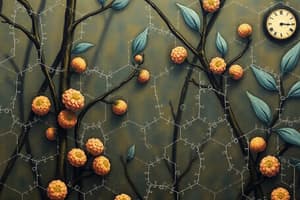Podcast
Questions and Answers
A molecule with the chemical formula C6H12O6 is probably a _____.
A molecule with the chemical formula C6H12O6 is probably a _____.
monosaccharide
Humans can digest starch but not cellulose because humans have enzymes that can hydrolyze the alpha-glycosidic linkages of starch but not the beta-glycosidic linkages of cellulose.
Humans can digest starch but not cellulose because humans have enzymes that can hydrolyze the alpha-glycosidic linkages of starch but not the beta-glycosidic linkages of cellulose.
True (A)
How is lactose classified?
How is lactose classified?
as a disaccharide
Which of the following could amylase break down?
Which of the following could amylase break down?
Which of the following categories includes all others in the list?
Which of the following categories includes all others in the list?
Which type of lipid molecules function primarily in energy storage?
Which type of lipid molecules function primarily in energy storage?
The primary structural component of a cell membrane is:
The primary structural component of a cell membrane is:
What two functional groups are bound to the central carbon of every free amino acid monomer?
What two functional groups are bound to the central carbon of every free amino acid monomer?
If a large protein is denatured by getting exposed to high heat, it will spontaneously refold into its original shape and regain its function once the temperature is brought back to normal levels.
If a large protein is denatured by getting exposed to high heat, it will spontaneously refold into its original shape and regain its function once the temperature is brought back to normal levels.
In the double helix structure of nucleic acids, cytosine forms hydrogen bonds with:
In the double helix structure of nucleic acids, cytosine forms hydrogen bonds with:
Nucleic acids are polymers made up of which of the following monomers?
Nucleic acids are polymers made up of which of the following monomers?
What is/are the variable structure(s) of nucleotides in a stretch of a DNA molecule?
What is/are the variable structure(s) of nucleotides in a stretch of a DNA molecule?
What is different in a ribonucleotide compared to a deoxyribonucleotide?
What is different in a ribonucleotide compared to a deoxyribonucleotide?
Which bonds are created to link amino acids together in a chain during the formation of a polypeptide chain?
Which bonds are created to link amino acids together in a chain during the formation of a polypeptide chain?
What type of bond is directly involved in the formation of an alpha-helix?
What type of bond is directly involved in the formation of an alpha-helix?
Which of the following is a difference between RNA and DNA?
Which of the following is a difference between RNA and DNA?
If one strand of DNA molecule has the sequence of bases 5'-ATTGCA-3', the other complementary strand would have the sequence __________.
If one strand of DNA molecule has the sequence of bases 5'-ATTGCA-3', the other complementary strand would have the sequence __________.
What determines the primary structure of a DNA molecule?
What determines the primary structure of a DNA molecule?
Flashcards are hidden until you start studying
Study Notes
Carbohydrates
- C6H12O6 is a monosaccharide, a simple sugar.
- Humans digest starch due to enzymes hydrolyzing alpha-glycosidic linkages, while cellulose's beta-glycosidic linkages are indigestible.
- Lactose consists of glucose and galactose, classifying it as a disaccharide.
- Amylase enzyme breaks down starch, which consists of glucose monomers with alpha linkages.
- Carbohydrates encompass various categories, including sugars and starches.
- Monosaccharides like glucose contrast with polysaccharides like glycogen.
Lipids
- Saturated fats contain no double bonds; any claim of multiple double bonds in their fatty acids is false.
- Membrane-forming lipids have a dual structure: polar heads that interact with water and nonpolar tails.
- Phospholipids serve as the primary structural component of cell membranes.
- Fats primarily function in energy storage.
Proteins
- Secondary protein structure includes polypeptide forms like α-helix and β-pleated sheet.
- Peptide bonds link amino acids to form polypeptide chains.
- Free amino acid monomers are characterized by an amino group and a carboxyl group on the central carbon.
- Denatured proteins lose functionality, indicating a strong correlation between protein structure and function.
- Alpha-helix formation occurs through hydrogen bonds between amino acid backbones.
- Tertiary structure involves interactions like backbone to side chain and side chain to side chain within a polypeptide.
Nucleic Acids
- In nucleic acids' double helix, cytosine pairs with guanine through hydrogen bonds.
- Ribonucleotides differ from deoxyribonucleotides by having a hydroxyl group on the 2nd carbon of their sugar.
- Nucleic acids consist of nucleotide polymers.
- RNA contains ribose sugar, while DNA possesses deoxyribose sugar, marking a key difference.
- Primary structure of DNA is determined by the sequence of deoxyribonucleotides.
- A DNA strand with the sequence 5'-ATTGCA-3' has a complementary strand with the sequence 5'-TGCAAT-3'.
- The base in nucleotides represents the variable structures present in DNA.
- RNA can catalyze reactions, a function not attributed to DNA molecules.
Studying That Suits You
Use AI to generate personalized quizzes and flashcards to suit your learning preferences.




